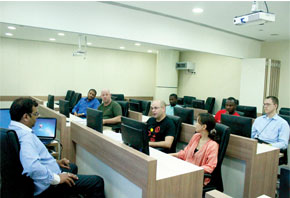
 The IT professionals today are trying to cope with the diminishing budget and the skeleton staff. The challenging environment has led to the adoption of cloud technologies in education as an easy attractive option. Elets News Network takes a look at the cloud solutions.
The IT professionals today are trying to cope with the diminishing budget and the skeleton staff. The challenging environment has led to the adoption of cloud technologies in education as an easy attractive option. Elets News Network takes a look at the cloud solutions.
With cloud becoming an important tool in the education sector, the market of cloud seems to be growing with a CAGR of 19.9% every year. The barriers to cloud adoption will gradually reduce with passage of time and education industry can leverage business advantage with this new technology.

EVP, Research and
Marketing, Chalk and
Talk
The education sector is one of the most demanding sectors of all, especially with the tremendous growth after the adoption of new age teaching methods. The higher education sector has seen massive growth spurring the demand for automation of education sector at all levels in order to cater to the needs of the industry.
With the burst of technologies in the education sector, the stakeholders expect correct information fast, accurate, anytime and anywhere. Cloud computing has been well accepted within the industry with a positive outlook.
Sameer Bora, EVP, Research and Marketing, Chalk and Talk feels that the schools today have realized the importance of learning. The cloud computing brings out the best in the world. Bora adds that there is a lot of scope for education sector in imparting good quality education with the adoption of new cloud solutions specifically designed for the education sector.
Responding quickly to the students’ demands, the IT professionals today are trying to cope with the diminishing budget and the skeleton staff strength. The challenging environment has led to the adoption of cloud technologies in education as an easy attractive option.
The Cisco cloud solutions are designed in such a way as caters to the need of the schools and the colleges at par. The Cisco cloud for education combines Cisco Unified Data center, Cisco Cloud Intelligent Network, and Cisco Cloud services into an integrated architecture that helps the educators deliver highly secure, cloud-based services.
The benefits of using Cisco Cloud services for education include:
- Redefining teaching by extending interactive multimedia learning environments to anyone, anywhere
- Expediting delivery of administrative services
- Simplifying operations, saving time and cutting cost
- Reducing risk and reinforcing the security
Cisco has host of cloud solutions and services specific to every school and university. Building, deploying cloud networks, offering cloud services, or consuming applications from partner hosted cloud networks becomes easier.
Chalk and Talk, one of the solution providers of cloud solutions, has launched head modo, a cloud based solution for schools, to meet the requirement. The solution is customized according to the needs and requirements of the institutions or schools.

CEO Koenig Solutions
Manoj Davey, Co-founder and Head Engineer, Cherrypick Technologies has developed Cherrypick Box, a cloud based solution, that helps the schools and the colleges use in-house apps for any work like sharing calendars etc, which are common requirements. “There should be a mechanism to allow the pioneering teachers, students, to work on cloud, putting mass learning and so on so forth,” feels Davey.
“No doubt, the cloud solutions facilitate communication and collaboration among the learners but learning can be accepted if group of learners interact with themselves which can be possible through cloud. Collaborations can make a big difference across the traditional boundaries,” explains Udai Singh, President, Global Technology Strategy, NIIT Ltd.
“One of the advantages of deploying Cloud Solution is that people don’t require any infrastructure. They can travel anywhere, can be based in any location and access the information from anywhere. They can also access it from e mail, reduce the size of IT team. In the education space, cloud is very good but how education industry embraces this technology is more important. It is a very good business opportunity for the vendors or solution providers,” feels Rohit Aggarwal, CEO Koenig Solutions.
The market for education cloud computing is fast gaining the traction and the key players like IBM, Adobe, Cisco, Huawei Technologies, EMC, NetApp, NEC, Salesforce. com are growing fast. According to the markets and the surveys, total education cloud computing market is likely to grow from $5.05 billion to $12.38 billion by 2019 at a compound annual growth rate of (CAGR) 19.9%.
Today what is required is a fundamental shift in the thinking of the end user about cloud technology before it has a chance to really benefit the schools. Technology vendors and solution providers must work to reposition IT within the mindset of the professionals working in the education sector. Singh opines, “There are two-three key points when we look at the number of potential students we have whether from schools or colleges. The total base of users is huge but the consumption is small. So to increase the consumption we need good infrastructure to support the learning which takes certain amount of time. Cloud solutions allow you to scale up and down based on actual use or consumption.”

President, Global
Technology Strategy,
NIIT Ltd.
Market Size
The market for education cloud computing is fast gaining the traction and the key players like IBM, Adobe, Cisco, Huawei Technologies, EMC, NetApp, NEC, Salesforce.com are growing fast. According to the markets and survey of the markets, total education cloud computing market is likely to grow from $5.05 billion to $12.38 billion by 2019 at a compound annual growth rate of (CAGR) 19.9%.
The education cloud computing market brings along innovative outcomes for K-12 and higher education. The market faces challenges in the form of compliances and slow advancement of technology among the buyers.
PWC India has proposed a 12.3% increase of budget for education with bigger thrust on schools and higher education. INR 100 crore has been budgeted to establish and start the virtual classrooms by leveraging technology for larger benefit of the population residing in the far flung areas. However, the increased spending needs to be accompanied by higher penetration of education in the remote villages.
The expected market size for the Indian education sector in FY 2015 is INR 602,410 crore from INR 341,180 crore in FY 2012. At present, higher education system comprises of about 700 universities and over 35,000 colleges.
According to Rohit Aggarwal of Koeing Solutions, the cloud services market can be categorized into three categories based on the type of service offered:
- SaaS (Software as a Service)
- IaaS (Infrastructure as a Service)
- PaaS (Platform as a Service)
Of all three, SaaS is expected to grow the fastest, followed by IaaS. The market for SaaS can be further differentiated into: Cloud Security, Mobile SaaS Cloud offerings and Corporate & SMB SaaS Cloud services. The global cloud software services (SaaS) market is currently valued close to $ 22 billion and is expected to grow to $ 50.8 billion by 2018.

Practice lead and Solution architect education
Adoption Rate
Despite a fast growing market, adoption of the technology ceases to be minimal. The IT departments or the IT advisers must educate the head teachers by demonstrating the tangible and pecuniary benefits of IT to the school system not only from a budgetary standpoint but also the way it improves the educational experience for the students, the teachers and the parents.
The expected market size for the Indian education sector in FY 2015 is INR 602,410 crore against INR 341,180 crore in FY 2012. At present, higher education system comprises of about 700 universities and over 35,000 colleges.
As Sameer puts in, adoption of fullfledged cloud technology in schools today is between 5,000 and 10,000 among the private schools. Rest of the schools from the government and the public sectors must understand the benefits they accrue from the adoption. However, Sameer thinks that the adoption rate of cloud services will increase at school level in next 5 years. At the K-12 level the cloud technology adoption varies between 3% and 5% which is expected to grow to 10% in next 3 years.
Expressing agreement with Sameer, Davey also sees minimal adoption of cloud technology at the school level and feels that the market for cloud services will likely to evolve in next 5 years. Yogesh Agarwal, CEO, Applane feels that the adoption is less in the sector as they fear for the loss of sensitive data. The adopters have to change their mindset to embrace the technology and work in sync with the advancements. So there is a need to educate the institutes about the security of the data.
CV Raman, Practice lead and Solution architect education ‘school on cloud’ platform, Xchanging, gives a very interesting fact while talking about the adoption at the metro and tier 2-3 level cities.
He says, “We have cloud solutions for K-12 and higher secondary and we are deploying the solutions pan India. Today Punjab is providing education to secondary and higher secondary level and we are talking to both the sectors for the usage of cloud. Almost 3,000 to 4,000 schools have adopted the cloud solutions. Besides, we are also running a lot of projects in the metro cities but the size of adoption among the institutions is fairly high in the non-metro cities. They are growing in size and technology.”
Benefits of adopting Cloud technology
To gain benefits of adopting new cloud technology are listed as under
- A standard content delivery is ensured through a central location through multiple remote virtual classrooms.
- The students and the teachers can collaborate and study
- Cloud technologies ensure rapid access to infrastructure services, thereby rendering agility in rolling out newer products
- The teachers and the staff can focus on the core functions of the institution instead of looking at IT infrastructure and the application set up.
Applane deploys ERP solutions
The ERP solutions deployed at Universal Education Group helped the college streamline the education delivery mechanism through automation.

CEO, Applane
Profile
Universal Education is the fastest growing education enterprise in India and one of the largest private education groups in Western India. Today Universal Institutions are some of foremost schools and colleges in Mumbai, with strong links to academia, industry and the society. They have top rate study, social and sporting facilities.
Challenge
Universal Group wanted Applane for automating their processes with an easy to use management console to switch between functional applications with minimum downtime. Universal Education Group wanted all of its ten colleges to be managed individually from college premises and the group management to be able to setup, view and revise the policies for each school centrally. Also consolidated reports for all colleges were required to understand growth of the group. This called for a solution which had to be location agnostic, c ould be configured at college level, role based, secure, scalable and accessible at all colleges simultaneously.
Apart from these requirements, each college is different in terms of study pattern and in some cases in term of the curriculum colleges follow. So the system had to support a single organization with multiple colleges as its branches while ensuring smooth functioning of the individual colleges with better coordination, transparency & clarity.
Solution
Applane Education is made up of 16 seamlessly integrated modules and 5 comprehensive dashboards. Applane implemented the ERP simultaneously in all the colleges of Universal Education Group and provided dashboards that could be used to administer all the colleges. Applane configur ed all colleges under one organization using the concept of profit centers.
Each college was set up as an individual profit center so that the data is managed separately. Applane by default is a role based system so separate roles were available to principal, professors, librarians, fee managers, and other college staff. This makes sure that the data of a college is seen by the staff of that colleg e only and also the data being viewed is as per role.
For example, Transport Manager cannot see exam evaluation data for any student of his/her college. New roles were configured on management level, so that the individual and cumulative r eports of colleges can be viewed centrally. These included financial, academic and administrative reports. Also workflows were developed so that automatic alerts can be configured centrally. Similarly email and SMS functionality can be managed centrally. The complete system was redesigned from scratch considering the problems faced by a chain of schools.
List of modules implemented
Admission Management, Student Information Management, Student Attendance Management, Student Health Management, Examination & Evaluation Management, Time Table Management, Fee & Collection Management Transport management, Library Management, Hostel Management, HR Management, Asset & Expense Management Finance Management, Alumni Management, Lesson Planning, Inventory Management, Technologies used, Memcache API to boost performance by providing temporary, high-speed data access through a high-performance memory cache Task queues to run certain complex operations in the background, improving complex and lengthy process like report generation process responsive for users, Users API to provide SSO and multiple alternative login option via OpenID login which provides a seamless experience to access the applications, Images Java API to perform image optimization before saving in database like Student profile images etc., Blobstore API to efficiently store student documents and images, Cloud SQL for scalable data storage, Google Cloud Storage for saving database backup snapshots
Business impact
Implementation of Applane Education in the 10 colleges under the administration of Universal Education group led to streamlining of the education delivery mechanism through automation. Also, considerable cost savings and decrease of upto 20% TCO (Total Cost of Ownership) was observed. Through the admission module, the admission process was simplified across the colleges. The result generation module made it possible for Universal to gener ate results for all its students in very short time and with minimal errors.
After the successful integration of Applane, the Universal Educational Group is managing their all college data in a very smooth and efficient way and that too with pr oper access rights so that the data is not mismanaged or lost. Some users have complete access and some having access of particular branch or branches only.
Cultural Challenges
Though the cloud technology has improved for us to see the benefits, yet there are cultural challenges facing an academic environment. There is a huge gap in the strategic vision and understanding of available technology versus budgets available to deliver on that vision. In India the teacher and the student ratio is 1:12 so the whole concept of virtual classrooms, MOOCs is a massive challenge.
Today most of the cloud services do not have a track record on which to build the necessary trust to shift existing services without compelling benefits.
The course, curriculum in most of the institutes is not regularly updated. Reach of quality education in the villages continues to be a big challenge to overcome. Lack of internet connectivity in such areas is a huge bottleneck.
Increasing cost of infrastructure and the cumbersome task of switching from one cloud to another is a roadblock.
Teachers and institutions have not been technology savvy hence the adoption of new modes of teaching is slow.
Architecture of cloud services
The cloud enables education sector to focus on its core activities, ensure smooth operation and improve the quality of teaching course content. But, on which application or infrastructure, the education industry should develop their cloud solution is a challenge. NIIT cloud campus-pioneer in using cloud technology believes in developing the cloud structure on SaaS (Software as a Service) model which is easy to operate and understand.
The institutions have also options of leveraging PaaS (Platform as a Service) and IaaS (Infrastructure as a Service) based offerings too without any need to invest in procurement and maintenance of infrastructure. The SaaS is a top layer and a model of software deployment where a provider approves of an application to customers for use as a service.
PaaS offerings can be customized around a particular area like content management or its offerings can provide for every phase of software development and testing.
| AREAS WHERE CLOUD COMPUTING CAN HAVE IMPACT | |
| CATEGORY | CLASSROOM |
| TECHNOLOGIES | |
| Interactive engagement | Centralised faculty assisted by local teachers Students interaction with teachers, delivering lectures, presentations or response to polls and questions |
| Collaboration | Students and teachers collaborating on projects by creating and sharing content, delivering lectures, presentations Communication by messaging or video |
| Mobility | Extend classrooms and labs with mobile devices such as smart phones,Tablets virtual desktop technologies facilitate remote access |
| Real-time assessment | Adapting lessons based on observations of student interactions, notes taken technologies facilitate remote annotated or updated via electronic media |
| ADMINISTRATIVE TECHNOLOGIES | |
| CRM | Student life-cycle management enables better management of recruitment and admissions, student financial aid and billing, student records and performance, transfers and alumni relationship |
| ERP | Educational institutions manage internal and external resources including physical assets, financial and human resources |
| Business intelligence | Teachers and students use analytics in classrooms; evaluating and establishing curriculum |
| Smart campus | Universities appear to be cities in themselves The CIO is responsible for public safety, transportation, energy and water management, building maintenance, student services |






















